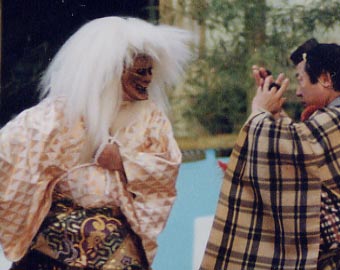

Nohgaku
 Nohgaku is said to have been perfected by Zeami in the 14th century. Nohgaku also called "Noh" is a kind of dramatic play based on dances and songs. Noh expresses human life symbolically and artistically. Zeami claimed the basic concept of the Nohgaku is "Yugen" (profound and quiet elegance). Even in the 21st century, it is still alive and fascinates its audiences.
Nohgaku is said to have been perfected by Zeami in the 14th century. Nohgaku also called "Noh" is a kind of dramatic play based on dances and songs. Noh expresses human life symbolically and artistically. Zeami claimed the basic concept of the Nohgaku is "Yugen" (profound and quiet elegance). Even in the 21st century, it is still alive and fascinates its audiences.
How to move masks
Nogaku has settled into set patterns after a long history of more than 600 years of seeking the "beauty of yugen."Choreographics are fixed for each song. The movement of the mask is also specified in detail. Although each mask's expression cannot actually change, through choreography and song a character can portray great sadness in the beginning and yet become joyful and glad at the end. Simple up and down or left to right movements are the extent of mask motion.
Example of how to move
 |
Moving the face down is called "kumorasu" (cloud) .The effect is a shadowing on the entire face and shows sadness. It can also be used to express perplexity, or shame. Putting a hand on the eyes, expresses crying. |
 |
Through the Nohmens, you can see "yugen" and "spirit" in the set patterns of the Nohgaku. |
 |
Moving the face up is called "terasu" (shine). It expresses a bright feeling. Moving a Sensu (fan) in front of the chest expresses great delight, or moving it left and right gives one the sensation of seeing the landscape. By swinging the mask left and right swiftly, it attempts to express intense emotion. |

